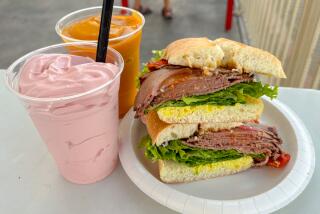How to induce kids to eat more fruits and veggies? Hire a chef
This news will not blow back any foodies’ aprons, but is a useful reminder to lunch ladies and school boards everywhere: When it comes to making the good-for-you parts of school lunches delicious enough to actually eat, chefs really do earn their keep.
That finding emerged from a trial designed to assess the relative contributions of two key factors -- taste and choice -- in improving school childrens’ lunchtime nutritional choices.
You need both, the researchers found. But absent tasty food, choice alone is doomed to fail.
As part of her efforts to combat child obesity, First Lady Michelle Obama launched the Chefs Move to Schools program in 2010, and the current study set out to test whether it made a difference. The study was published Monday in JAMA Pediatrics.
When children exercise their small measure of independence in the school lunch line, they do respond well to choice, according to the study. So giving kids a range of options for fruits and vegetables -- and presenting the healthiest options in attractive ways -- prompts these tough customers to pick them more often, the study said.
But when it comes to getting kids to not just pick but actually eat more fruits and vegetables over the long haul, there’s no substitute for a real chef, the researchers found. Presenting the chef’s offerings in an appealing way worked far better than just gussying up traditional school-lunch fare with more choice and better presentation.
The picky eaters -- students at 14 elementary and middle schools in two urban, low-income Massachusetts school districts -- didn’t respond to the changes immediately. Three months after chefs began visiting schools, tweaking menus and offering food-preparation tips to cafeteria workers, students were choosing to put more vegetables on their trays. But they weren’t eating them, the researchers found.
At four months, participating schools were divided into two groups. In one group, fresh fruit, unsweetened nonfat milk and other healthful choices were prominently displayed in attractive bowls and touted in promotional posters. In the other group, foods were displayed in typical cafeteria fashion, with healthier and less-healthy options getting equal billing.
When fruit and vegetable offerings were tastier, more varied and backed by good PR and presentation, kids not only chose them more often, they ate them too. The researchers were able to tell because they carefully measured what school children chose in line and what they threw away at the end of the lunch period.
At these schools, 78% of students choose a fruit offering and 76% chose a vegetable. Those kids ate, on average, 59% of the fruits and 53% of the vegetables they chose, according to the study.
At the schools that kept doing things the way they always had, only half of the students put fruit on their trays and one-third chose a vegetable. Those kids ate, on average, 67% of those fruits and 30% of those vegetables, the researchers found.
“After long-term exposure to the enhanced meals, the chef intervention ... led to significant increases in the amounts of fruits and vegetables consumed,” they wrote.
The explanation for this turnabout kept coming back to the chef and his or her expertise. “This was likely because of the increased palatability of the foods, an increase in the variety of fresh fruit options, and the weekly presence of a professional chef in the lunchroom,” the researchers concluded.
The study’s authors underscored the importance of time and patience in improving the choices children make, and reminded parents -- who probably already knew this -- that only with “repeated exposure to new school foods” will children open up to them.
And they suggested that a one-time consultation by a chef (no matter how famous he or she may be) is unlikely to sway kids’ tastes toward better foods. The “sustained involvement” of a chef is more likely to deliver “greater effects on childrens’ diets,” they wrote.
Follow me on Twitter @LATMelissaHealy and “like” Los Angeles Times Science & Health on Facebook.







